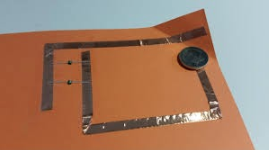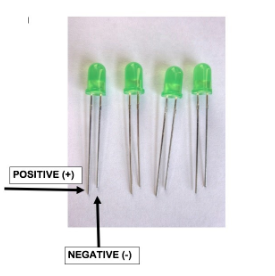
Paper Circuit Greeting Cards

Overview
Students will use knowledge of series circuits to create a closed circuit greeting card.
Learning Objectives
Students will:
- Understand circuits.
- Be able to use design thinking to create a circuit.
Vocabulary
Vocabulary Words:
-
Circuit: A circuit is a complete path around which electricity can flow. It must include a source of electricity, such as a battery.
-
Paper Circuit: A paper circuit is a low-voltage electronic circuit that is created on paper or cardboard using conductive copper tape, LEDs and a power source such as a coin-cell battery.
-
Closed Circuit: A Closed Circuit is a complete electrical circuit around which current flows or a signal circulates Similar Words: loop.
-
Series Circuit: A series circuit is a circuit in which resistors are arranged in a chain, so the current has only one path to take.
Pre-planning
To prepare for this lesson:
Your students will need some circuit background to complete this project.
To complete this project the students will need LED Lights, Batteries and Copper Tape. They can be be purchased on Amazon.
Here is a good video tutorial and step-by-step instructions by Chibitronics.
Below are ideas if this is your first time trying this with students
Here is a project on How to Make a Greeting Card.
Here is a possible design thinking template.
Watch the video on CIRCUITS or follow the tutorial:
Possible reflection questions.
Accommodations
See the Accommodations Page and Charts on the 21things4students website in the Teacher Resources.
Steps
Directions for this activity:
The teacher will say to the students, "We have been talking about circuits in Science. Today you are gonna build a circuit greeting card."
Review circuits with students
Show the students an example of a sample card that you have created yourself or use one of the videos or tutorials from pre-planning.
Have the students decide who they are creating the card for and what they want the card to do.
Use Design thinking template if applicable
As students work, many will find that they can code multiple circuits, or if they create their own cards, they can create their own closed circuits.
Students will come into issues. It is important that STUDENTS solve the issue. Here are the most common issues:
DO NOT CUT THE COPPER TAPE - This could create a broken circuit. Show students how to fold accordingly around corners.
POSITION OF LED LIGHTS - Make sure your LED lights are correctly positioned for positive and negative.
POSITION OF BATTERY - Make sure your battery is positioned ON the copper tape. DO NOT TAPE THE BATTERY COMPLETELY. This will break your circuit.
WATCH YOUR TAPING - Less means more. Tape down enough to secure but be cautious of how much tape. You don’t want to tape down too much and break the circuit.

Assessment Options
Different options for assessing the students:
- Observations
- Check for understanding
- Students can reflect on the project using this Google Document.
- Students can also share out on SEESAW, Google Classroom, Flipgrid or Schoology.
- Design thinking template
MITECS COMPETENCIES & ISTE STANDARDS
MITECS: Michigan adopted the "ISTE Standards for Students" called MITECS (Michigan Integrated Technology Competencies for Students) in 2018.
Innovative Designer
4a. Students know and use a deliberate design process for generating ideas, testing theories, creating innovative artifacts or solving authentic problems.
4c. Students develop, test and refine prototypes as part of a cyclical design process.
4d. Students exhibit a tolerance for ambiguity, perseverance and the capacity to work with open-ended problems.
Computational Thinker
5a. Students formulate problem definitions suited for technology-assisted methods such as data analysis, abstract models and algorithmic thinking in exploring and finding solutions.
5d. Students understand how automation works and use algorithmic thinking to develop a sequence of steps to create and test automated solutions.
Devices and Resources
Device: PC, Chromebook, Mac, iPad
Browser: Chrome, Safari, Firefox, Edge, ALL
App, Extension, or Add-on:
Websites:
60 Seconds DIY Paper Circuit Tutorial
CONTENT AREA RESOURCES
ELA
Students could write a piece to go along with their card.
Integrated Arts
Create a design and create a paper circuit.
Science
Students learn about circuits and circuitry.
Credits
This task card was created by Courtney Conley, Utica Public Schools. January 2020. Updated March 2025.


